There are few things more frustrating than playing your guitar and then – ping – your guitar string just broke. But what causes guitar strings to break? And, importantly, how do we stop it?
I remember very clearly standing on stage and breaking a string midway through a set. I had to finish the show with my high e string wildly waving around!
I’ve put together this list of the most common causes of guitar string breakages and the steps that you can take to avoid them happening to you!
Why do guitar strings break?
There’s no one reason why guitar strings break, it’s often a combination of a lot of little things. Maybe your guitar string broke while tuning, or perhaps went out in a blaze of guitar-solo glory. Whatever the reason, here’s a list of the most common causes, and what you can do to avoid them.
Remember: If it’s a one off incident, then it might be nothing. But, if it’s repeatedly happening, you’ll likely have a problem.
1. Worn-out strings
Age catches up to us all, and guitar strings are no exception. Whether it’s friction slowly wearing them down, or the weeks and months of being under constant tension – sooner or later (hopefully later) your guitar strings will give out.
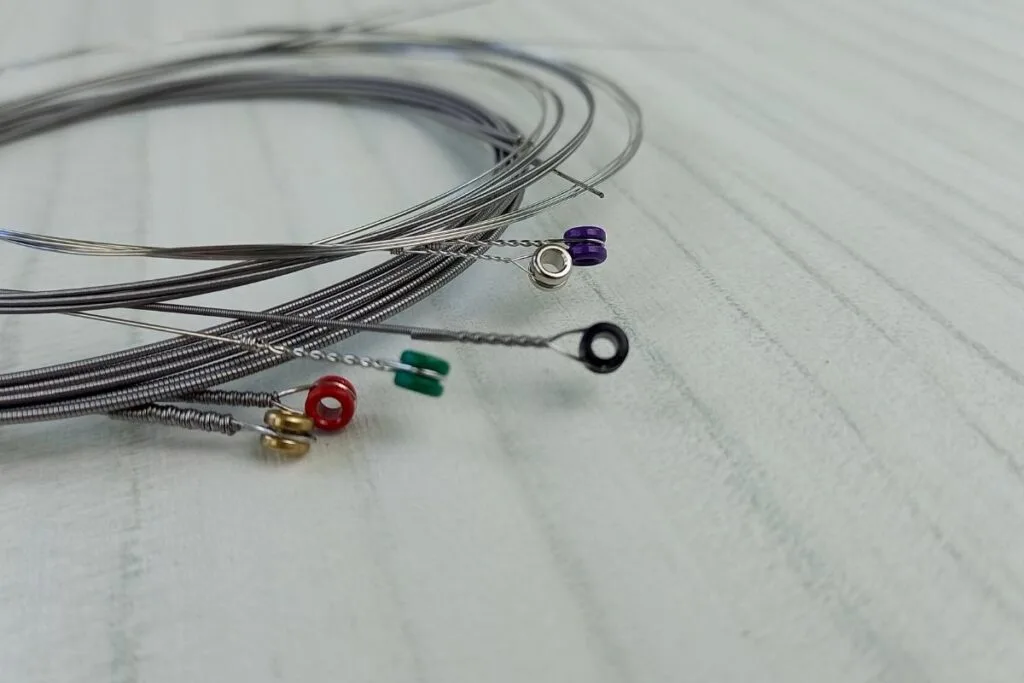
What happens is that the metal wire your strings are made of becomes weaker as it’s repeatedly bent and stretched. Surprisingly, it also becomes less flexible in a process called “work hardening”. All of this results in a string that’s no longer able to handle the everyday pressure from strumming, tuning, or bending.
But, this shouldn’t be a common occurrence. If it is, then it’ll likely be something else causing your strings to break.
How to prevent it
This is the easiest problem on the list to prevent. All you need to do is change your guitar strings on a regular basis. “Regular” will mean different things to different people, depending on a wide range of factors. But, changing your strings before they become too old is the best way to prevent an unintended snap!
I’ve written a short guide on how often you should change your guitar strings full of useful tips that teach you when it’s time for a new set.
2. Rusty or dirty strings
Whenever you pick up and play your guitar, any dirt or sweat that’s on your hands will transfer onto your strings and fretboard. Over time, this builds up to form a gross, sticky substance. The moisture from this causes the metals in your guitar strings to oxidize, which creates rust.
Another important factor is how you store your guitar. Leaving your guitar in a humid environment can also cause the strings to rust from the moisture in the air. Likewise, dust and air particles can land on the strings and make them dirty.
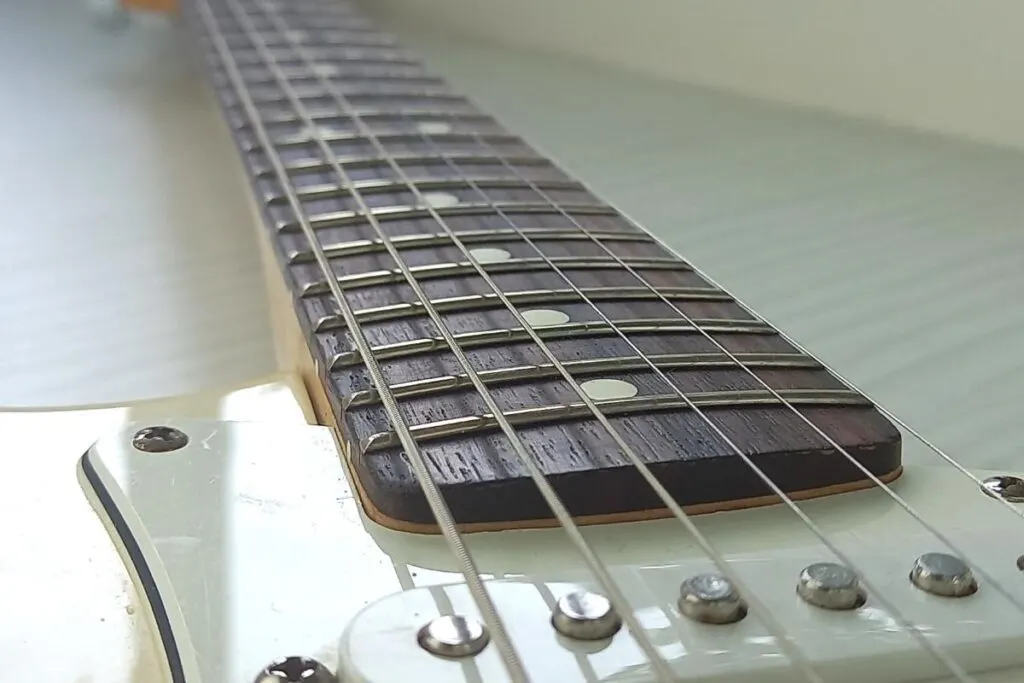
Rust, and the grime itself, stops your strings from being elastic and creates weak spots which not only stops your strings from sounding good, but can lead them to an early string grave.
It’s one of the biggest problems that causes strings to prematurely snap – and very easily avoidable!
How to prevent it
Learning how to clean your guitar strings regularly will stop sweat and grime from building up on your strings – making them last a lot longer. So will washing your hands before playing!
If you’re a naturally sweaty player, or live in a humid climate, you might also want to look into coated guitar strings. These guitar strings have a slight polymer coating that shields them against moisture (and dirt) so you’ll get more life out of them.
Another key factor is storing your guitar properly. Keeping your guitar in its case will make the strings last longer as they are less exposed to moisture and dust.
3. Sharp saddles
Your strings aren’t the only thing at risk of dirt. Guitar saddles (where your strings rest on the bridge) are a prime target for grime and rust build up.
Built up dirt can narrow the saddles and “grab” the string, causing increased tension and causing a breakage.
But, this isn’t the only problem. Years of constant pressure from strings can create small, spiky imperfections on the saddles called “burrs” that can snap your strings.
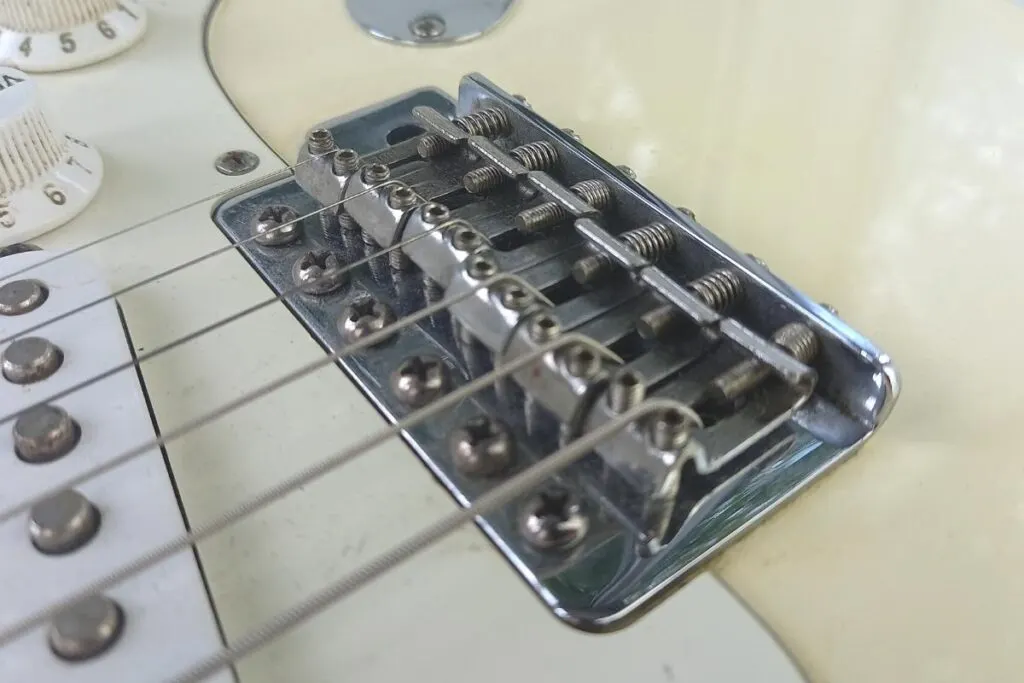
Ideally, your saddles should be smooth and even; allowing for a fluid movement of the strings as they bend and flex.
If your string has snapped at your guitar saddles, then it’s a tell-tale sign of built-up dirt or a burr – especially if your string snapped while tuning or using the tremolo.
How to prevent it
Like before, washing your hands before playing is a great way to remove problem grime and dirt that would otherwise end up on your bridge.
Another tip is to make sure that your saddles are properly lubricated. You can use a specialized product, but I like to use an ordinary pencil. The graphite from the pencil acts as a lubricant that keeps the string moving nice and smoothly over the saddles. Next time you change your strings, give your saddles a quick rub with a pencil – trust me, it helps!
4. High guitar action
Your guitar’s action is the distance between the strings and the fretboard. The higher the action, the more distance there is between the two. This means that you need to push harder to get the string into contact with the fret.
By pushing harder, you’re putting more pressure on the string, mostly at the saddles. Not only does this make your guitar much harder to play, but the extra pressure can cause your strings to snap.
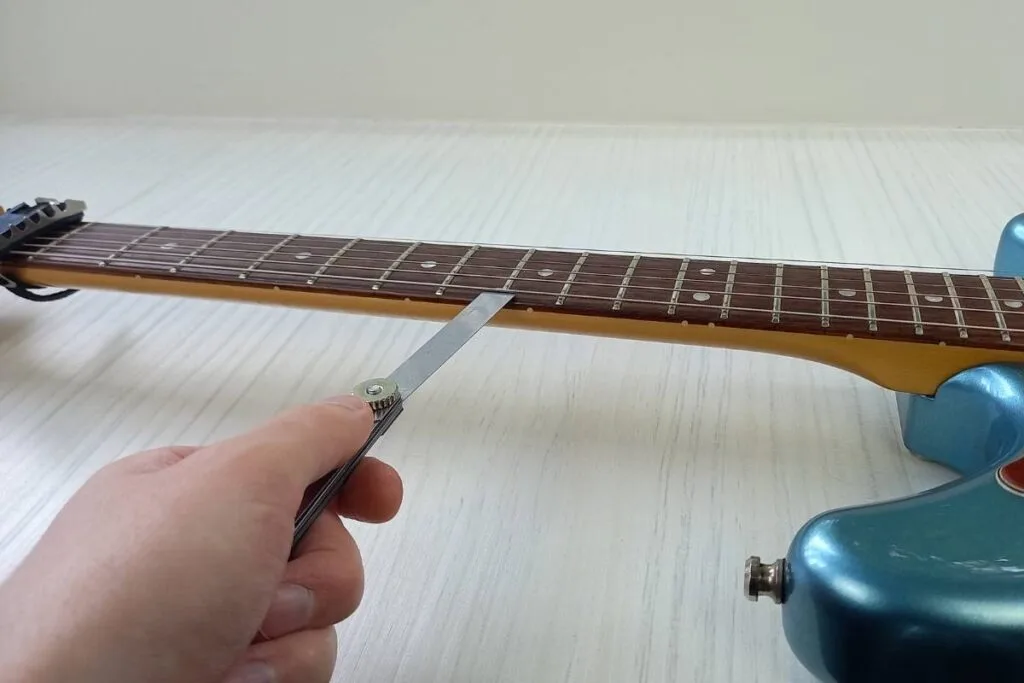
Your strings shouldn’t require much force to fret a note. If you find that you have to push hard, then it’s likely that your action is too high.
The perfect string action should be low enough to where you can easily fret a note, but without causing problems like fret buzz or dead frets.
How to prevent this
To fix your guitar’s action, you’ll have to set up your guitar. I’ve written about how to do this in my guide on how to fix fret buzz. Keeping the action low to the fretboard puts less pressure on the saddles and will prevent accidental snapping.
5. Nut problems
The nut, like the saddles, is where the strings rest but it’s at the top of the guitar. Every nut has slots that are carefully carved to hold the strings. If the nut is deformed in any way, then it can cause the strings to break.
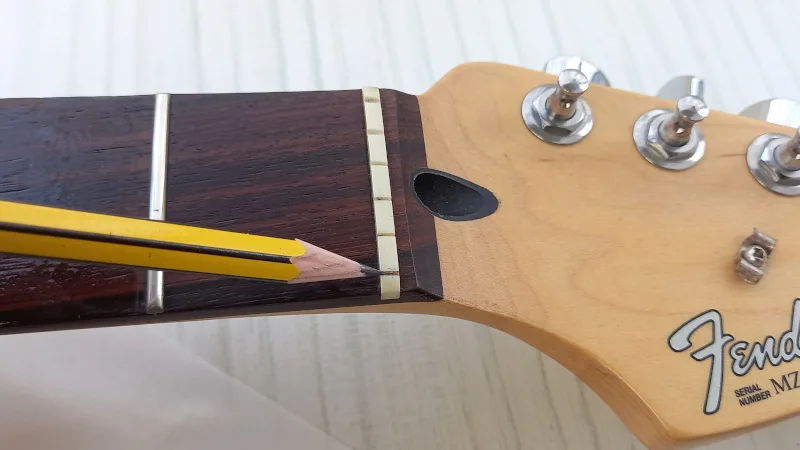
As with saddles, any imperfection causes a variety of problems. Built-up dirt and grime can restrict the movement of your string, causing it to snap either when tuning, bending, or using the whammy bar. Likewise, burrs can cut into the guitar string, causing it to snap under high pressure.
But, this isn’t only caused by wear and tear. Cheaper guitars often have lower quality nuts that are either more likely to deform, or aren’t designed correctly in the first place.
If you’ve had guitar strings break at the nut, it’s likely the source of your problem!
How to prevent this
Loosen your strings and check the nut slots for any rough spots. If you have an old guitar string, you can pass this backwards and forwards through the nut slot (like flossing) to work away any burrs. If the issue continues, take it down to your local guitar store where they can smoothen the nut with a file.
Also, make sure that the nut is lubricated. Exactly the same as the saddles, use a pencil tip to rub some graphite into the slots.
If the nut slots aren’t cut properly, or it’s become too deformed, consider replacing it with a better quality nut. It’s a fairly cheap upgrade that has a surprising impact on the overall tone of your guitar.
6. Playing technique
If you’re a heavy-handed player, then you’re putting a lot of extra pressure on your strings which can cause them to break. This could be caused by inexperience or overzealousness – or a combination of the two.
In my experience, the main culprit is excessive string bending. Bending a string past its limit will cause it to break. Considering most string bends are done using the lighter, more delicate strings – it’s a recipe for disaster!
Heavy, thrash style strumming and picking can also put undue pressure on your strings. It only takes a light touch to get a sound out of your guitar, so maybe try taking your foot off the gas a little bit.
How to prevent this
If you’re a new player, then practice playing with a proper technique. There are plenty of online resources, but I’d recommend an in-person lesson if you can arrange it.
If it’s more down to the style of music you’re playing, then it might be a case of using the wrong string gauge. For heavier styles of music, like heavy metal, you’ll have more luck using a slightly thicker set of strings.
7. Using the wrong string gauge
It’s important to use the right string gauge for the style of music, or tuning, you’re playing in. Using a heavy string gauge for higher tunings, or a lighter gauge string for heavy playing, can cause your strings to snap.
Heavier gauge strings have a higher string tension, which is why they’re great for lower tunings. Imagine trying to tune your low E string up to the pitch of your high E string. It’ll snap long before it gets there. Add in string bends, and you’ve got even more tension.
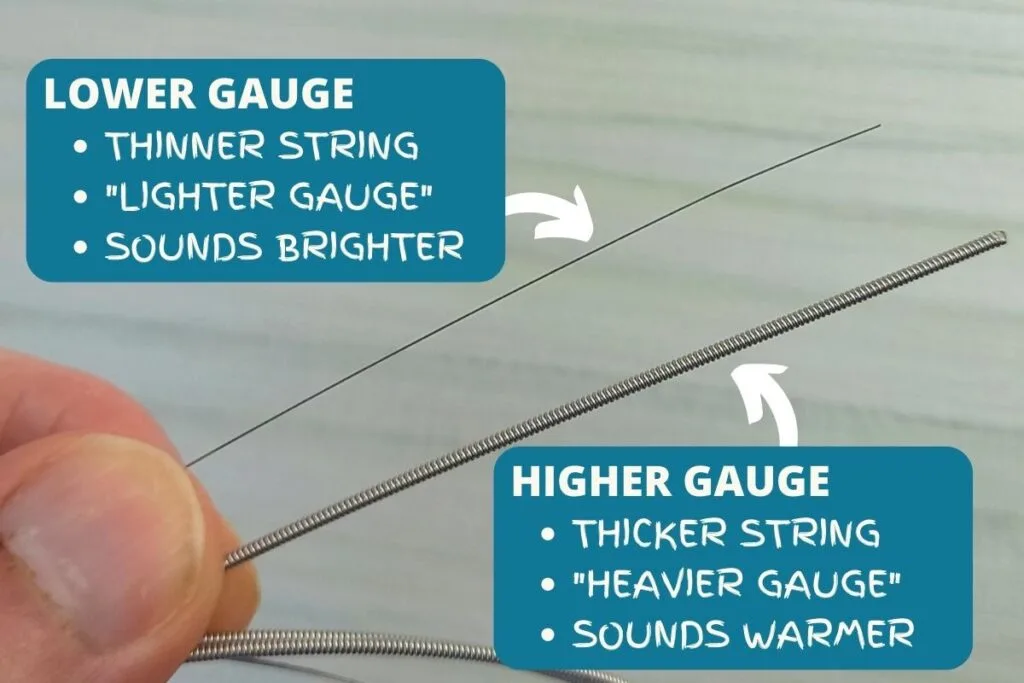
Lighter gauge strings are thinner and more delicate. As such, strumming or picking hard can cause them to snap easier than thick strings.
How to prevent this
Use the proper string gauge for your tuning. If your guitar is in standard tuning, then I’d suggest using 10’s or 9’s. If you want to play heavy styles of music, like metal or hard rock, try out a thicker string like an 11, or even higher if you’re drop tuning your guitar.
8. Sharp tuning posts
Your tuning posts put up with a lot of tension on a daily basis. Over time, that tension can cause burrs on the post, which will dig into your strings. This is more common on cheaper guitars as they’re often made of a lower quality metal.
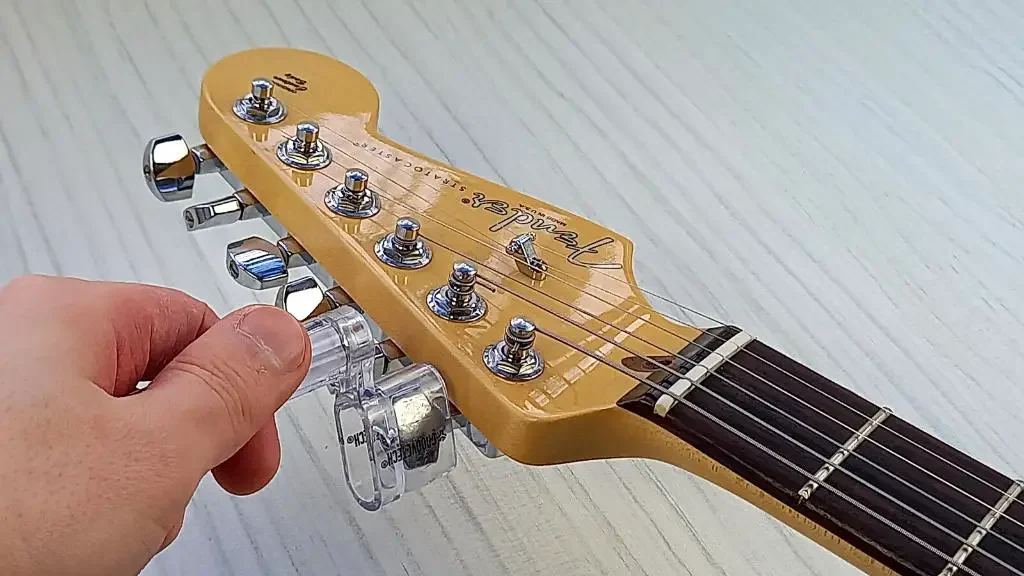
But, it’s not just burrs. Like any other part of guitar, the tuning posts are susceptible to dirt build up. Any built up dirt can create an uneven surface which acts like a burr.
If your strings break at the tuning post, this is probably the reason why.
How to prevent this
The best way to prevent dirt build up is to wipe your tuners down and store your guitar in its case between use.
If your tuning posts already have burrs, then you can try wearing them down with a guitar string. But, I’d recommend taking them, for a professional filing by a luthier at your local guitar store.
9. Poor quality strings
You know what they say: buy cheap, buy twice. While the cheap strings you’ve found may look like a good deal, it’s likely that they use budget materials and have poorer quality control than the bigger name brands.
In my experience, cheaper strings tend to break more at the ball end. So, if you find your string is breaking at the bridge (not the saddle) then it could be down to the quality of the string.
How to prevent this
Buy your guitar strings from a name brand string manufacturer such as Ernie Ball, D’Addario, or DR Strings to name a few. If you’ve not heard of the string manufacturer before, then do your research before buying them!
10. Sharp frets
Whenever you play guitar, your strings are coming into constant contact with your guitar frets. Both of these rub against each other and wear each other down. So, over time, your frets will become worn.
This wear can cause the dreaded fret buzz or other undesirable sound problems, but it can also affect your strings. Pits that form in the fret can “catch” your strings as you bend, snagging them. Likewise, burrs can form on the fret edges, cutting into the string.
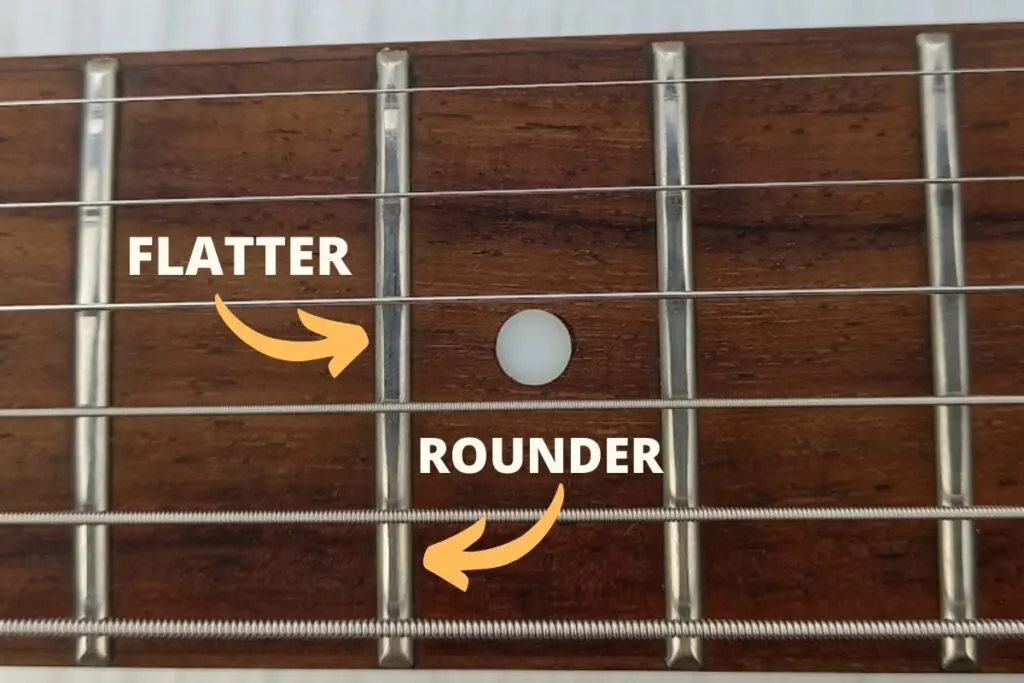
If your string is snapping somewhere on the fretboard (usually in the same place) then it’s a sign of a problem fret.
How to prevent this
Make sure that your guitar is properly set up, you’re using the right string gauge for the style you’re playing, and you’re playing with the proper technique (i.e. not pushing too hard on the fretboard).
If your frets are too far gone, then take them to your local guitar store for a fret dressing (reshaping the existing fret) or a refretting (replacing the existing fret with a new one).
11. Using thick picks
Your guitar pick is constantly hammering against your guitar strings, and can be the cause of them breaking. Thicker guitar picks put more pressure on the strings, which both increases the risk of them snapping and wearing out quicker.
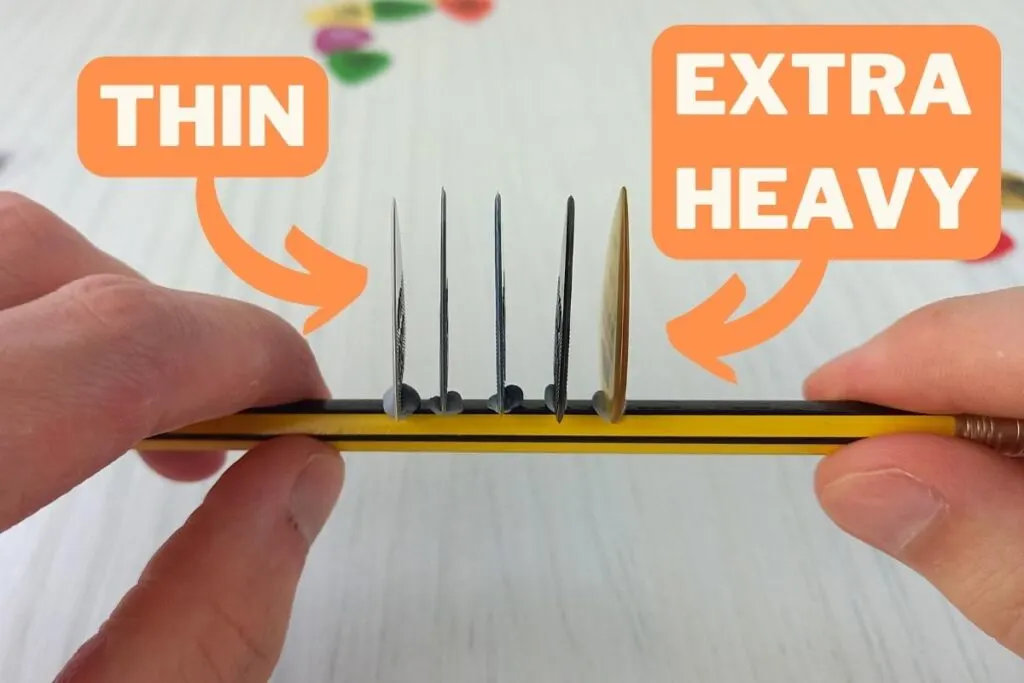
Another key factor is that your picks change shape the longer you use them. Like a rock in a river, your pick is slowly worn away by your strings. The flatter your pick is, the more damage it can do to your strings. A pointier pick means less contact and less resistance, so it’s better for your strings.
But, if your pick gets worn away and develops a misshapen edge or burr, then it can snag the strings and cause them to snap.
How to prevent it
Try using a thinner guitar pick. Dunlop makes a guitar pick “taster pack” with a wide variety of different types of pick. I reviewed them in my best guitar pick for a beginner article. They’re really affordable, and you might find something new you like!
If you’re happy with your pick choice, then just make sure to keep it fresh! When it starts to lose its point, swap it out for a new one. Your strings will thank you (and it’s easier to use!).
What to do if your guitar string breaks
If your guitar string breaks, then the only thing you can do is to restring your guitar. Whether or not you replace the whole set of strings is a judgement call by you. If it’s just a one-off accident, or you’ve found the problem and fixed it, then replacing one will be fine.
But if your strings are old and have given out, then it’s likely that the others will follow soon too. It’s important to keep an eye out to know when it’s time to change your strings to prevent the risk of them breaking during practice or performing live.

Conor is a music producer, multi-instrumentalist, and all-round enthusiast from the UK with over 15 years of experience. He’s the founder and sole-content creator for the roundtable audio blog and YouTube channel.
